Books
Books
published in 2024
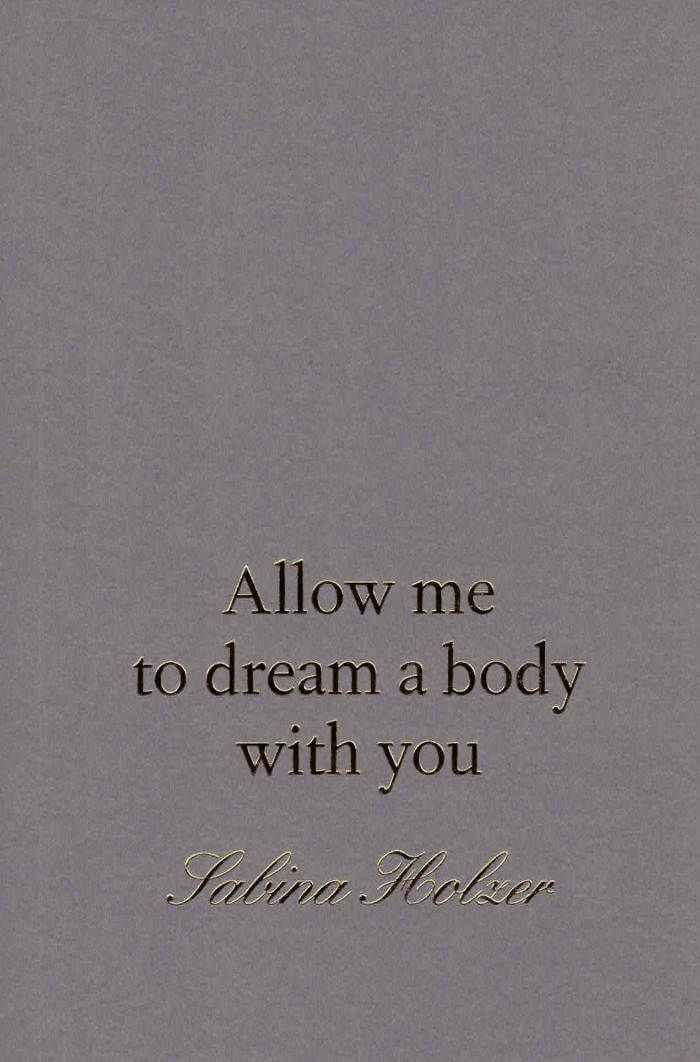
Allow me to dream a body with you
Writing from the body, from nervous impulses, sensations and gestures, but also from our being carried by matter, language and history, Sabina Holzer explores how writing may become ‘a way of singing and slip over into liminal, latent meanings and potentials.’ How to stay close to the body of the word? To perceive some of the multiplicity of our reality and ways of being, she incorporates somatic practices, ecology and new materialism, fables and science fiction in her writing. Allow me to dream a body with you gathers poetic essays and stories that delve into the fine grain of our corporeal entanglements and embeddedness. ‘Would an encounter between you and me be possible without all this?’
Sabina Holzer works in the field of expanded choreography. Her performances, interventions and texts explore the ecologies of human and more-than-human bodies with particular attention to movement and matter. She engages in practices of collaboration, philosophy, ecology, science fiction and poetry.
Graphic design: Michaël Bussaer
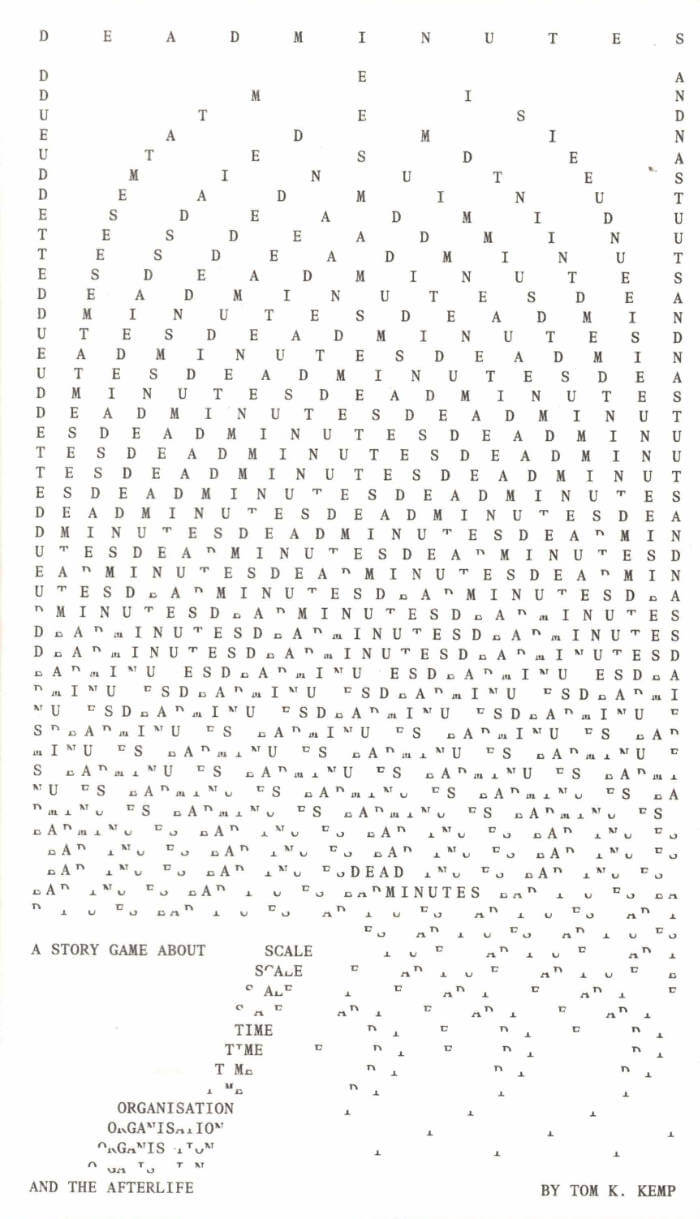
Dead Minutes
Dead Minutes is a storytelling game about systemic change in an undesirable afterlife. You, the players, will decide what this hell, underworld or land of the dead is like, what its problems are, how change happens there, and what the complications might be when altering something so big, involving so many dead people, over so much time. It’s a game about impossible seeming actions at impossible seeming scales, making difficult choices, and dealing with unexpected outcomes.
The first half of this book gives you everything you need to play a session of Dead Minutes, which takes 2-5 hours with 3-6 people.
The second half features an essay by Patricia Reed that expands on the concepts of heuristic fictions and vital zombies in relation to the afterlife, and a series of afterlife generating 'seeds' contributed by different types of writers - a demonic boardroom presentation by writer and art critic Habib William Kherbek, a ritual from horror game designer Samuel Clarice Mui Shen Ern, a premise by Arthur C Clarke award winning author Chris Beckett, and a letter from Selma Selman.
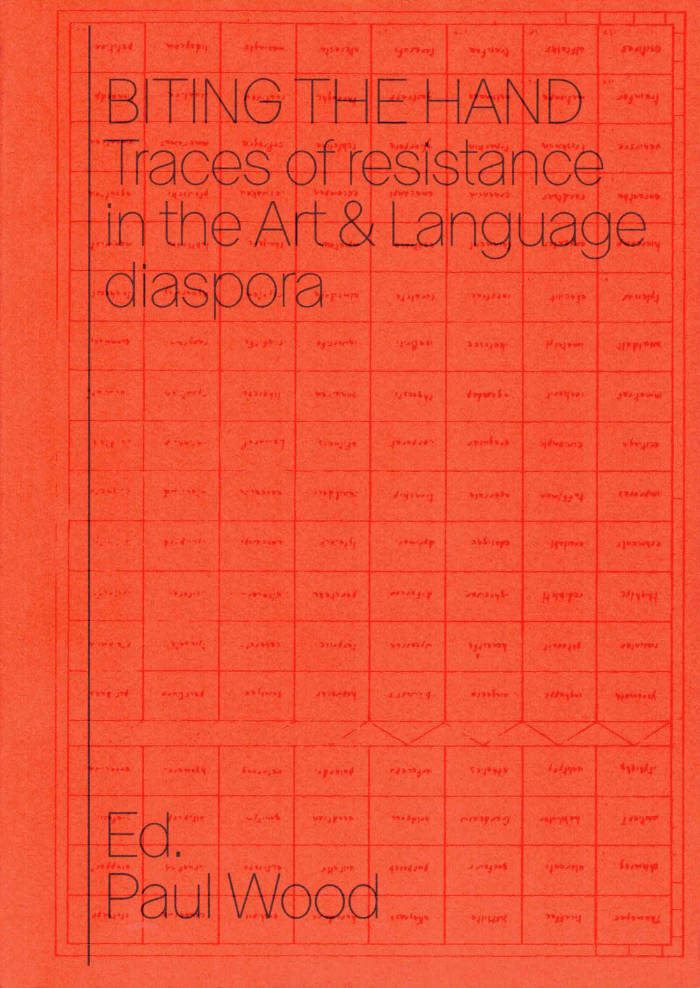
Biting the Hand – Traces of Resistance in the Art & Language diaspora
Extensive survey of the politically outward-looking Conceptualism emerging from Art & Language in the UK. Especially considering its critique of the norms of Modernist art practices in contemporary art, particularly practices of art education.
Edited, compiled and introduced by Paul Wood, Biting the Hand: Traces of Resistance in the Art & Language diaspora is about a dissident formation of artists active in the UK in the 1970s and 80s.
The book tells the story of artists engaging with a critique of then-contemporary modernist art education, who have embarked on a series of theoretical investigations which became increasingly politicised under the pressures of an evolving social crisis. Increased racism, unemployment and attacks on the organised working class all raised questions about how a critical art might respond.
By the late 1970s, these radical artists, mostly in the orbit of the Art & Language group, were producing posters and leaflets for a wide range of left-wing causes, as well as analyses of the politics of art and design education and the role of cultural ideology in maintaining consensus. In the 1980s, as Thatcherism tightened its grip, those involved went their separate ways into areas as diverse as media work, trade unionism, health and education.
Biting the Hand has three parts: a retrospective introduction setting the formation in its historical context, and two annotated documentary sections presenting examples of the work as both text and image, written and edited by Paul Wood.
It also includes a foreword by Sezgin Boynik, publisher, and an afterword by Ann Stephen, curator and art historian, further expanding on the book's subject.
For many years Paul Wood worked for the Art History Department of the Open University. His publications from that period include Conceptual Art (2000), Western Art and the Wider World (2013), and the four-volume anthology Art in Theory (1990-2020), co-edited with Charles Harrison and others.
Edited, compiled and introduced by Paul Wood.
Foreword by Sezgin Boynik; afterword by Ann Stephen.
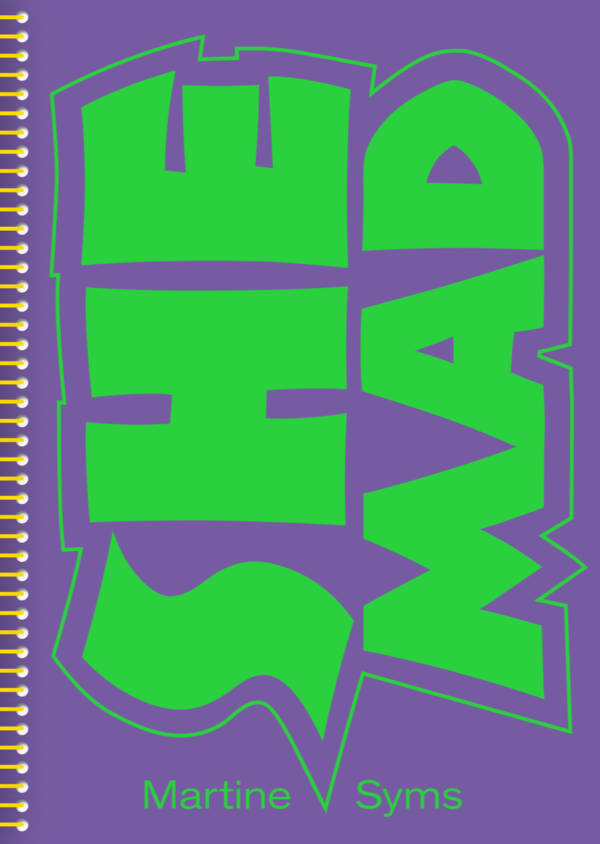
She Mad
She Mad gathers materials and documentation on Martine Syms' seminal episodic project of the same name. Each episode of this series takes a different format, using various narrative formats, from sitcoms to TikTok videos, and includes filmed footage as well as research materials. Each episode revolves around a protagonist, also named Martine—an overachieving, stoner graphic designer who lives in Hollywood and wishes she were an important artist.
The first episode Pilot for a Show about Nowhere (2015) merges a semi-autobiographical account of Syms' own life as a young black woman with a video essay-like narrative on the history of commercial television and its assumed target audiences. The episode Laughing Gas (2016) draws on early cinema, specifically the 1907 silent film of the same name by Edwin Porter, one of the earliest examples of a black female actress, Bertha Regustus, performing an independent role on-screen. Intro to Threat Modeling (2017) is told through email exchanges, screengrabs, and an avatar, outlining the effects of surveillance on subjectivity. The episode Bitch Zone (2020) takes us to an empowerment programme for teenage girls founded by supermodel and business mogul Tyra Banks.
Published on the occasion of the exhibition She Mad – Season One at Bergen Kunsthall, Norway and the Museum of Contemporary Art, Chicago, USA.
Martine Syms (born 1988 in Los Angeles) is an American interdisciplinary artist who has earned wide recognition for a practice that combines conceptual grit, humor, and social commentary. Her works explore how mass media shapes and frames identities and cultures. Drawing from early cinema, television, the internet, social media, and ambient footage produced by phones and surveillance, Syms addresses the ways in which representations of black identity and gender appear in the public imagination.
Edited by Axel Wieder.
Texts by Jadine Collingwood, William Pym, Axel Wieder.

all this here, now.
The haunting and intimate account of a group of young adults trying to come to terms with a friend’s premature death.
Ananke’s death rips a huge hole in the lives of their friends. A member of the group reflects on their shared mourning, remembering times past: childhood holidays and idyllic summers, as well as tensions and arguments. Ananke is a constant, enigmatic presence, yet remains mysterious and out of reach. When the numbness of trauma becomes too much to bear, the group impulsively takes a road trip to dig up Ananke’s ashes and bring them back to the sea by the hut where Ananke used to live.
Stern’s contemplative, ethereal yet vivid prose brings heightened sensibility to the present moment and the obliquity of memory. Flouting gender pronouns and written entirely in lowercase, all this here, now. is a vision of a more collectively grounded fiction where ‘we’ is stronger than ‘I’. The effect is as meditative as it is compulsively engaging, delivered in Damion Searls’s distinctive translation.
Winner of the Swiss Book Prize
Winner of the Prisma Prize for LGBTQI+ Literature

A Working Life (paperback)
The first new collection since Evolution from the prolific poet, activist, and writer Eileen Myles, a “Working Life” unerringly captures the measure of life. Whether alone or in relationship, on city sidewalks or in the country, their lyrics always engage with permanence and mortality, danger and safety, fear and wonder.
a “Working Life” is a book transfixed by the everyday: the “sweet accumulation” of birds outside a window, a cup of coffee and a slice of pizza, a lover’s foot on the bed. These poems arise in the close quarters of air travel, the flashing of a landscape through a train window, or simply in a truck tooling around town, or on foot with a dog in all the places that held us during the pandemic lockdowns. Myles’s lines unabashedly sing the happy contradictions of love and sex, spill over with warnings about the not-so future world threatened by climate change and capitalism, and also find transcendent wonder in the landscapes and animals around us, and in the solitary and collective act of caring for one another and our world.
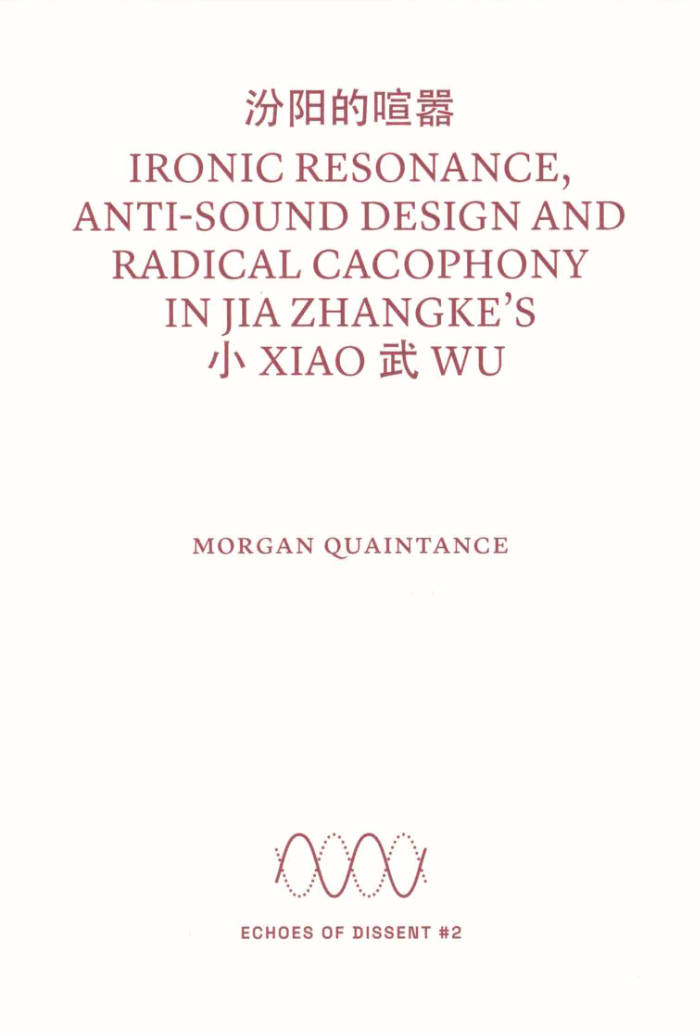
Ironic Resonance, Anti-sound Design and Radical Cacophony in Jia Zhangke's Xiao Wu
In the context of The Skin of the World program at Courtisane festival 2024, Morgan Quaintance was invited to reflect on the use of sound in Jia Zhangke’s Xiao Wu (Pickpocket).
This is the second publication in the Echoes of Dissent series, devoted to the politics of the soundtrack.

Meditations
A manual of meditations on grief blocked by trauma, pliers, goats, remedies, meaning, conduits, suicide, eggs, times, tutting, God, lifts, treasury tags, wrecking yards, Douglas Barrowman, involuntary spasms, front desks, manganese deficiency, weevil shit, Mr Sheen, coal potential, the bison, The Final Cut, tone of voice, trillions of cicadas, Elisabeth Koolaart-Hoofman, bogus antler cannibalism, the Preces Gertrudianae, parodies of communication, “Cary Grant’s Wedding,” the corruption of youth, a tripod or cable, Culverwell on the Vacuola, geese, Hemans’s line on Mary Tighe, annihilation, the proletariat, plastic bags, La Compiuta Donzella di Firenze, poetry, rooms, beheadings, S106 obligations, and planks. Containing single, double, triple, and sextuple sestinas, in the old mode of retrogradatio cruciata, and other canzoni, crushed to prose.

Octopus notes #11
Baptiste Pinteaux, Martin Laborde and 1 more
The eleventh issue of the journal-collection that brings together academic writings, interviews with artists, critical essays and artists' interventions in the form of inserts.
Featuring: Madalena Anjos, Zoe Beloff, Jean-Claude Biette, Vittoria Bonifati, Christine Burgin, Moyra Davey, Migle Dulskyte, Martha, Edelheit, Hélène Giannecchini, Donna Gottschalk, Birgit Hein, Gaëlle Hippolyte, Megan Hoetger, Jacques Julien, Sophie Lapalu, Sibylle de Laurens, Anne Lefebvre, Liz Magor, Andrea Mazzella, Marlene Monteiro Freitas, Zibuntas Miksys, Vali Myers, Gaspard Nectoux, Jeffrey Perkins, Elisa Pône, James Robert Baker, João dos Santos Martins, Giovanna Scotti, Samuel Steward, Billy Sullivan, Sabrina Tarasoff, Paul Thek, and a long previously unpublished conversation (50 pages) between Paul McCarthy and Sabrina Tarasoff.
Octopus notes is a journal that gathers critical essays, academic writing, interviews, archival documents and artists' projects since 2013. Each issue exists without a theme, but shapes echo through its content.

Groove, Bang and Jive Around
New edition of Steve Cannon's riotous 1969/71 erotic novel Groove, Bang and Jive Around, "an underground classic of such legendary stature that New York's black cognoscenti have transmogrified the work into urban myth," with a foreword from Darius James and an afterword by poet Tracie Morris.
Despite decades of notoriety as one of the "filthiest books in the world," Steve Cannon's first and only novel, Groove, Bang and Jive Around, has hardly been read since first being published by the Paris- based Ophelia Press in 1969.
Due to its scarcity, the New York Press deemed it "an underground classic of such legendary stature that New York's black cognoscenti have transmogrified the work into urban myth." This debut, revised for release by Olympia Press in 1971, cemented Cannon's place as a stalwart of the East Village and key figure in New York's black avant-garde—inspiring a generation to break with staid literary modernism, according to Cannon's friend and collaborator Ishmael Reed, for whom its release "signaled a resurfacing of the irreverent, underground trickster tradition of black orature." Seeped psychedelia and hoodoo, this erotic farce follows Anette, a fourteenyear- old runaway, from the outhouse of a New Orleans juke joint to the land of Oo-bla-dee, a realm of bacchanalian self-determination founded by Dizzy Gillespie. Inspired equally by Chester Himes and Women's Liberation, the author claims—as Ophelia put it, Groove, Bang and Jive Around is an absolute necessity "for everyone who wants to know where and how the action takes place in Sex and Soul."
"If there's a dirty prayer, this is it. Groove, Bang and Jive Around will invariably piss people off, that's the plan and its delight. It's gorgeously uneven, like a country road, it's squawking & sonorous like great live music, indeed, it is that. Groove, Bang is poetry and a novel out loud, and Steve Cannon, who wrote it was a huge heckler and a funny man and I wish I could thank him for this wonderful disturbing, deeply wrong (hot) and light-footed book that somehow fell out of reading history he has given us and now it has fallen back in."—Eileen Myles, author of a Working Life
Steve Cannon (1935-2019) was a writer who shaped the literary history of Manhattan's Lower East Side. He was the founder and executive director of A Gathering of the Tribes, an East Village nonprofit and exhibition space, and the publisher of a magazine of the same name. Tribes, which operated from Cannon's Alphabet City townhouse, functioned as a salon where artists and musicians such as David Hammons, Sun Ra, and Butch Morris could reliably be found among a cohort of younger poets emerging from the Nuyorican Poets Café scene. Born to a preacher in New Orleans, Cannon relocated to New York from England in 1962, where, alongside such luminaries as Amiri Baraka and Calvin C. Hernton, Cannon joined the Umbra Workshop, a cornerstone of the 1960s African American avant-garde poetry and publishing. In 1973 he, Ishmael Reed, and Joe Johnson cofounded the influential literary and audio/visual imprint Reed, Cannon, and Johnson. As a poet, playwright, and professor, Cannon mentored a generation of writers including Eileen Myles and Paul Beatty, and taught across the City University of New York system for more than three decades.
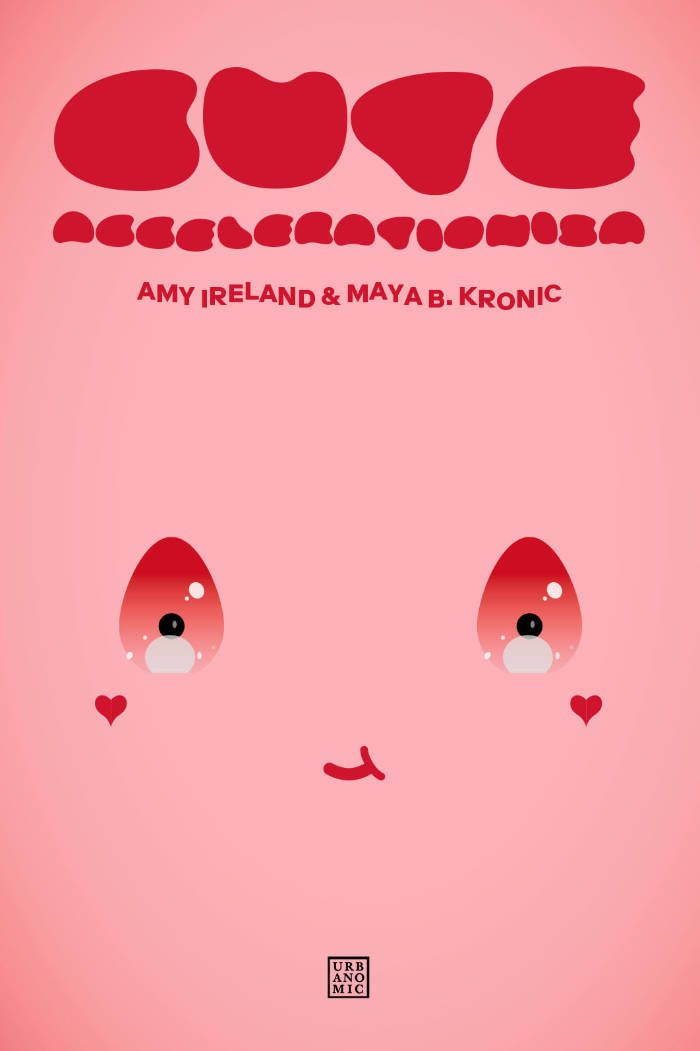
Cute Accelerationism
Involuntarily sucked into the forcefield of Cute, Amy Ireland and Maya B. Kronic decided to let go, give in, let the demon ride them, and make an accelerationism out of it—only to realise that Cute opens a microcosmic gate onto the transcendental process of acceleration itself.
Joining the swarming e-girls, t-girls, NEETS, anons, and otaku who rescued accelerationism from the double pincers of media panic and academic buzzkill by introducing it to big eyes, fluffy ears, programming socks, and silly memes, they discover that the objects of cute culture are just spinoffs of an accelerative process booping us from the future, rendering us all submissive, breedable, helpless, and cute in our turn. Cute comes tomorrow, and only anastrophe can make sense of what it will have been doing to us.
Evading all discipline, sliding across all possible surfaces, Cute Accelerationism embraces every detail of the symptomatology, aetiology, epidemiology, history, biology, etymology, topology, and even embryology of Cute, joyfully burrowing down into its natural, cultural, sensory, sexual, subjective, erotic, and semiotic dimensions in order to sound out the latent spaces of this Thing that has soft-soaped its way into human culture.
Traversing tangents on natural and unnatural selection, runaway supernormalisation, the collective self-transformation of genderswarming cuties, the hyperstitional cultures of shojo and otaku, denpa and 2D love, and the cute subworlds of aegyo and meng, moé and flatmaxxing, catboys and dogon eggs, bobbles and gummies, vore machines and partial objects, BwOs and UwUs…glomping, snuggling, smooshing and squeeeeing their way toward the event horizon of Cute, donning cat ears and popping bubbles as they go, in this untimely philosophical intensification of an omnipresent phenomenon, having surrendered to the squishiest demonic possession, like, ever, two bffs set out in search of the transcendental shape of cuteness only to realise that, even though it is all around us, we do not yet know what Cute can do.
Seriously superficial and bafflingly coherent, half erudite philosophical treatise, half dariacore mashup, 100 percent cutagion, this compact lil’ textual machine is a meltdown and a glow up, as well as a twizzled homage to Deleuze and Guattari’s A Thousand Plateaus. Welcome to the kawaiizome: nothing uncute makes it out of the near future, and the cute will very soon no longer be even remotely human.

Publi Fluor, Letter Business in Brussels
A self-taught typographic letterer, Chrystel Crickx used to cut out letters by hand and sell them by the piece in her Publi Fluor shop in Schaerbeek, Belgium. Commercialized between 1975 and 2000 for local advertising and signage purposes, these letters have since been digitized and made more widely available to users outside of the Belgian borders and in other contexts. At the margins of standard means of communication, they have contributed to shape (and still do) the urban visual landscape, in Brussels and elsewhere.
This non-standard, collective essay attempts both to recount the life of a type model — as well as of its successive authors and their tools — while expanding the field of investigation to examine the cracks between the different stories summoned up by Chrystel Crickx's practice summons up.
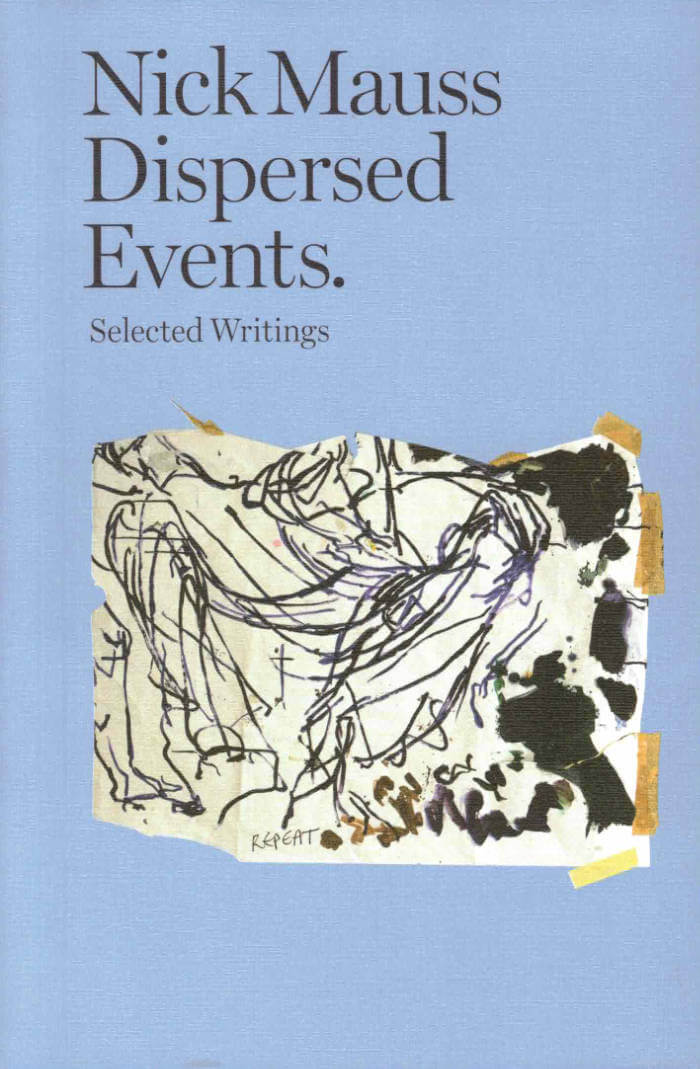
Dispersed Events. Selected Writings
Dispersed Events brings together for the first time Nick Mauss’ essays from the last fifteen years. Shimmering with the urgency of a new generation of queer thinkers, Mauss’ writing refracts contemporary art through histories of decorative art, film, theater, and dance.
An artist renowned for critically and poetically reconfiguring inherited genealogies and hierarchies of visual culture and art history, Mauss engages writing as a space for relentlessly activating counter-histories, repositioning the voice of the artist and the readers along the way. Whether he considers the practice of artist Lorraine O’Grady, the radical fashion of Susan Cianciolo, the anarcho-vaudevillian theater of Reza Abdoh, or the potential for textiles to disclose a different way of thinking, Mauss insists on the intense power of forms and feelings in their actual rather than enforced prehistories. Reevaluating experiments in fashion, dance, and the decorative arts on the same plane as painting, sculpture and cinema, he locates art as taking shape in the middle of conversations—“between art history and any afternoon.”
“Among what might initially appear, following Mauss, ‘a wildly inscrutable web of lineages,’ the reader quickly perceives unexpected, unheralded, conjunctions: affiliations, alignments, and affinities. . . . It generates a conviction that, in the best sense, is partisan. Singular, independent, illuminating.” — from the foreword by Lynne Cooke

saké blue. Selected Writings
Can critical thinking spring from both a fortune cookie and Jacques Lacan’s most obscure seminar footnote? Estelle Hoy says yes. In saké blue, overpriced cheesecakes are the starting point for an essay on art writing; shoplifting in Berlin opens to a reflection on the economies of activist practices; fiction allows us to discuss the legacy of institutional critique, queer mélanges, or quiet melancholy. To her, the story of art becomes more nuanced in light of lyrics by Arthur Russell, the posthumous sorrow of Sylvia Plath, or a poem by Yvonne Rainer.
saké blue gathers critical essays, art reviews, and poetic fiction. Written in dialogue with the work of Martine Syms, Marlene Dumas, Hervé Guibert, or Camille Henrot, these texts combine the subjective and analytic, addressing power relations and the force of affect. Hoy spares nothing—and no one, exposing cultural clichés and urgent political issues through fast-paced acerbity. She advocates the work of women artists, mocks stereotypes, questions myths, and champions desire, sadness, and boredom. Simultaneously beautiful, lyrical, and cutthroat, her writing echoes to the reader like l’esprit d’escalier—we think of the perfect reply just a little too late.
“Estelle Hoy practises philosophy as an unsettled but deeply committed query into existing together. She reads, she looks, she writes, to find out something essential about the future and living for it.”
—Lisa Robertson, author of The Baudelaire Fractal
“Estelle Hoy's prose slap and bite, saké blue is a sharp pleasure to read.”
—Calla Henkel, author of Scrap
“Hoy’s renditions of all-too familiar scenes are made more visceral than life with sparkling prose and a sly attention to life’s many shifting values that feels more than appropriate for anyone truly interested in art.”
—Natasha Stagg, author of Artless
Edited by Antonia Carrara
With an introduction by Lisa Robertson

Énergies
Les sculptures et les films de Judith Hopf sont alimentés par des réflexions sur les relations que les êtres humains entretiennent avec la production et la technologie. Pour Énergies, sa première exposition monographique en France qui eut lieu conjointement à Paris à Bétonsalon et au Plateau, Frac Ile-de-France, l’artiste s’est concentrée sur cet élément invisible dont la quête accompagne notre quotidien et nos activités, produit par la conversion de ressources naturelles en puissance. Ce catalogue réunit des reproductions de dessins inédits, un entretien avec l’artiste et un texte critique de Tom Holert qui fait retour sur vingt années de travail.
Judith Hopf's sculptures and films are fuelled by reflections on the relationship human beings have with production and technology. For Énergies, her first solo exhibition in France, held jointly in Paris, at Bétonsalon and Plateau, Frac Ile-de-France, the artist focused on this invisible element whose quest accompanies our daily lives and activities, produced by converting natural resources into power. This catalog features reproductions of previously unpublished drawings, an interview with the artist and a critical text by Tom Holert, looking back over twenty years of work.
Textes / Texts
- François Aubart, Xavier Franceschi et Émilie Renard, "À propos d’énergie, d’amour et de chansons : conversation avec Judith Hopf"
- Tom Holert, "Changements de rythme : La méthodologie énergétique de Judith Hopf"
- François Aubart, Xavier Franceschi et Émilie Renard, "On Energy, Love, and Songs: Conversation with Judith Hopf"
- Tom Holert, "Changing Pace: Judith Hopf’s Energetic Methodology"
Traduction / Translation
Jean-François Caro
Louise Ledour
Typesetting : Olivier Lebrun
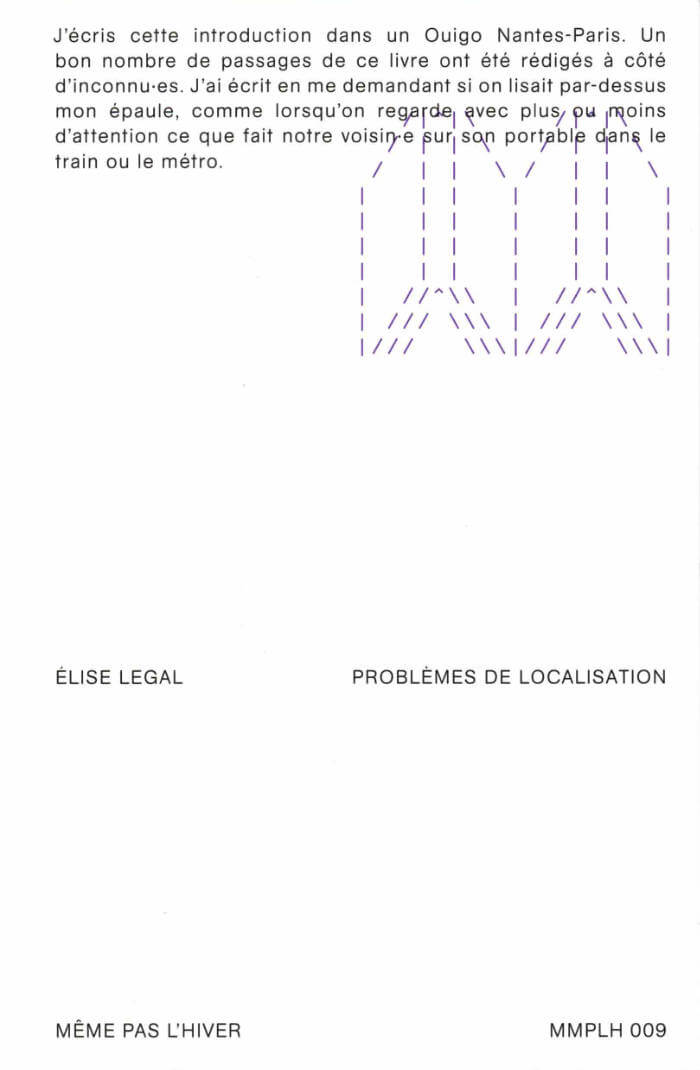
Problèmes de localisation
En sortant de l’école d’art, Élise Legal parcourt un monde de crises économiques, d’absurdités politiques et d’angoisses écologiques. Un monde dans lequel elle doit désormais légitimer sa démarche artistique dans des dossiers qui en font une fiction.
Problèmes de localisation contient sept textes, composés d’analyses critiques, de récits personnels et de poèmes, qui racontent cette entrée dans un environnement où circulent les corps, les marchandises, les informations et les capitaux. Élise Legal s’y déplace en voiture, en co-voiturage, en train, en bus ou en avion, découvrant ce que ce monde de transaction et de fluidité fait au langage. Elle cherche à comprendre comment il est incarné, échangé et habité dans les voix des pilotes d’avion, des startupers ou du président de la République, dans les textes de loi, les formulaires de demandes de bourses, la parole de ses enseigant·es, dans les textes de théorie critique comme dans la poésie des banquiers.
Élise Legal est artiste et autrice. Elle a étudié à l’École nationale supérieure des beaux-arts de Lyon et au Sheffield Institute of Arts. À travers une approche pluridisciplinaire qui mêle images trouvées, dessin et poésie, elle porte une attention particulière à la manière dont le langage et les corps coexistent. Elle poursuit également une thèse de recherche-création à Paris 8 qui porte sur l’agir politique de la poésie.
Graphisme : Olivier Lebrun

A User's Manual to Claire Fontaine
In the first monograph on the feminist conceptual artist collective Claire Fontaine, political theorist and somatic practitioner Anita Chari explores the artist's theoretical and political innovations to illuminate a more haptic, embodied approach to the practice of critical theory.
A User's Manual to Claire Fontaine explores the work of the feminist conceptual artist collective Claire Fontaine through the lens of her theoretical and political innovations, both inside and outside the context of contemporary art. Theorizing the ways in which Claire Fontaine's experimental approach can illuminate a more haptic, embodied practice of critical theory, this book delineates a series of theoretical techniques and procedures at the core of the artist's work, among them defunctionalization, Institutional Critique, human strike, tactile mimesis, desubjectivation, détournement, magic materialism, and feminist materialism.
Political theorist and somatic practitioner Anita Chari illuminates a larger field of practice for those working within the world of critical theory with this "user's manual" that seeks to reinvest theory with use value, drawing on the resources of critical contemporary art to engage with critical theory in ways that can become embodied, sensate, and tactile, and thus inform contemporary political practices.
"Fluently traversing critical theory, political philosophy, and artistic discourse, this is a brilliant, engaging book on the art and writings of Claire Fontaine—'readymade artist' and conceptual provocateur—as well as a vital elucidation of paths toward a transformative mode of living in the present. Writing with and through rather than, as usual, 'on' her subject, Chari provides her readers with a 'how-to' manual to Claire Fontaine's practice, finding in it a model for embodied resistance."—Tom McDonough, author of The Beautiful Language of My Century
Anita Chari is a political theorist and writer based in Portland, Oregon and is Associate Professor of Political Science at the University of Oregon. Her work explores the significance of aesthetics, artistic practices, and embodiment for critical theory and practice.
Claire Fontaine is a feminist, conceptual artist, founded in Paris in 2004.
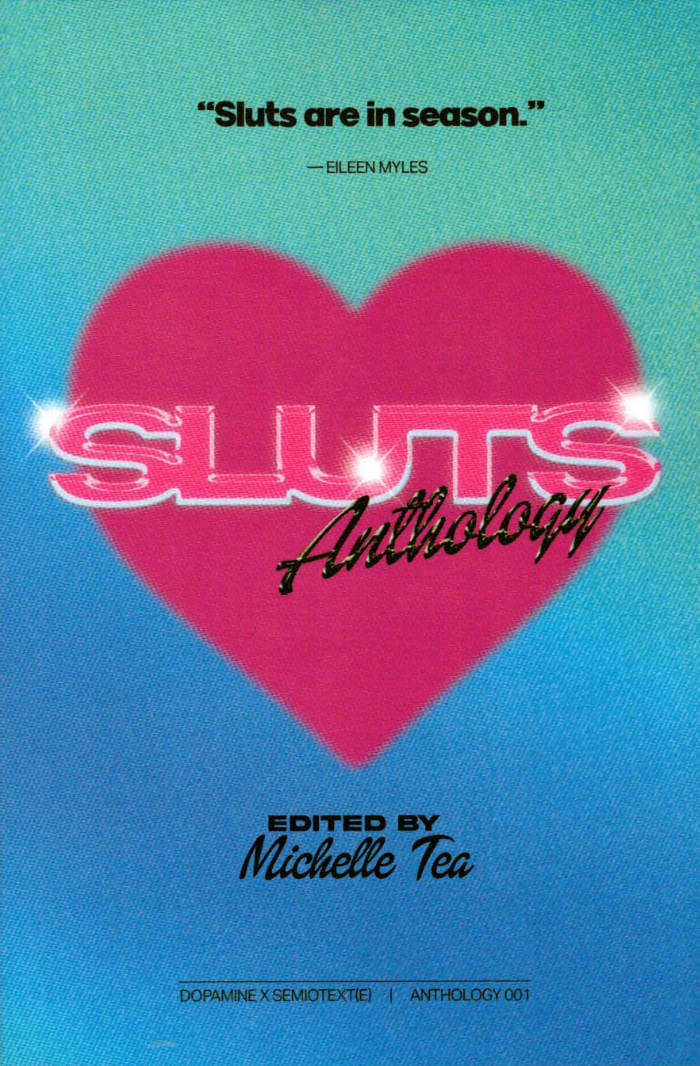
Sluts: Anthology
What it means to be sexually promiscuous in contemporary American culture, edited by cult-favorite author Michelle Tea.
SLUTS, the first publication from vulgarian queer publisher DOPAMINE BOOKS, is an exploration of what it means to be sexually promiscuous in contemporary American culture. Featuring personal essays, spilled secrets, fiction, memoir, and experimental works, SLUTS asks writers and readers to investigate the many ways the notion of the slut impacts our inner and outer lives, as a threat or an identity, a punishment or an aspiration, a lifestyle, an aesthetic, a philosophy and rallying cry. From hideous and terrifying first encounters to postapocalyptic polyamory, from unionizing sex workers to backstage tableaux of sex and drugs and rock and roll, SLUTS's stories probe the liberating highs and abject lows of physical abandon. Featuring work from performer Miguel Gutierrez, hailed by the New York Times as “an artist of ordered excess”; former Nylon magazine editor in chief Gabrielle Korn; award-winning author Brontez Purnell; Whore of New York author Liara Roux; National Book Critics Circle Award winner Jeremy Atherton Lin; and a host of additional artists and writers, SLUTS reveals the knowledges provoked by a dalliance with desire.
Contributors
DL Alvarez, Vera Blossom, Chloe Caldwell, Cristy Road Carrera, Sam Cohen, Tom Cole, Lydia Conklin, jimmy cooper, Lyn Corelle, Jenny Fran Davis, Cyrus Dunham, Hedi El Kholti, Robert Glück, Miguel Gutierrez, Gary Indiana, Taleen Kali, Cheryl Klein, Gabrielle Korn, Jeremy Atherton Lin, Nate Lippens, Meredith Maran, Carta Monir, Amanda Montell, Carely Moore, Bradford Nordeen, Baruch Porras-Hernandez, Kamala Puligandla, Brontez Purnell, Liara Roux, Andrea Sands, Daviel Shy, Jen Silverman, Anna Joy Springer, Laurie Stone, McKenzie Wark, Zoe Whittall.
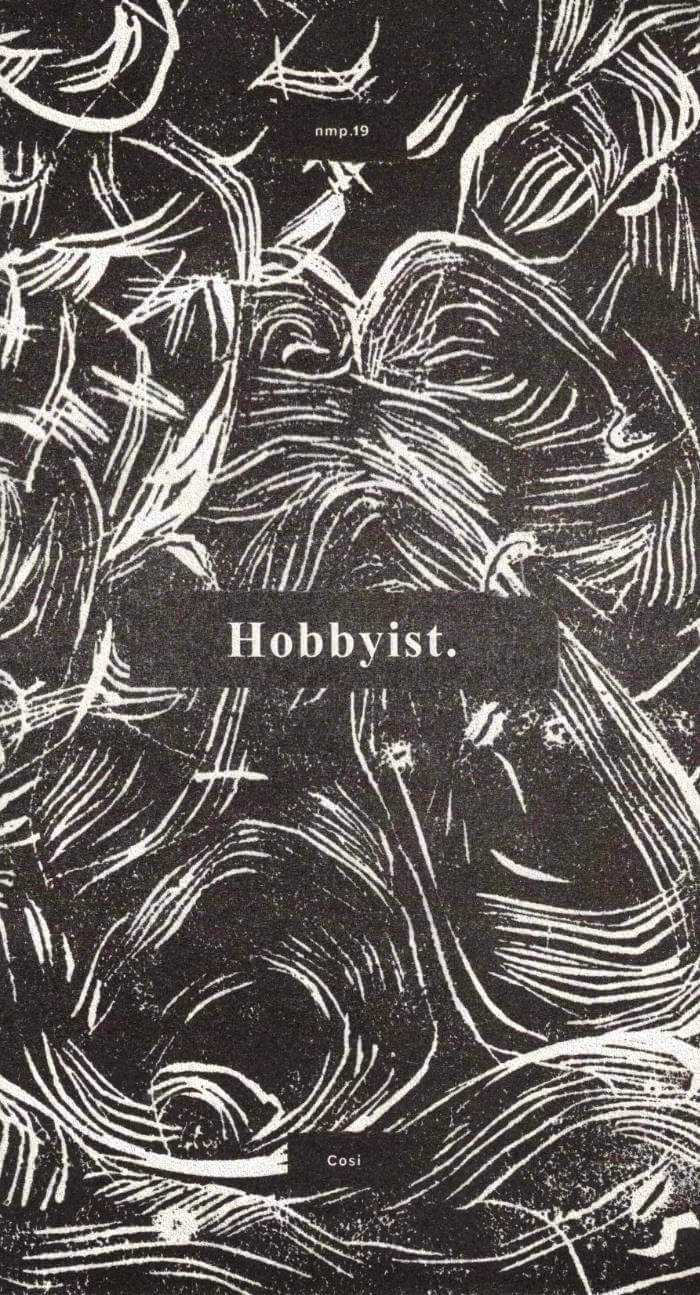
nmp.19 Hobbyist
artwork
black throughout, blue dust jacket
risograph, paperback
saddle stiched
clorine & acid free glassine sleeve
28 pages + dust jacket
152 x 280 mm
first edition, edition of 100
signed
"…this collection of some twenty-eight artworks, being automatic, incongruent — graphite, charcoal, ink — rigid, finite and complete — convey an underestimated and complex sense of play, by which the author — simply Cosi (as if distilling the self in a single word could be conceived as simple) — becomes a diagrammatic example of a brilliant and full-cream adult, so disinterested in the conformity of adulthood that more difficulty is placed within the absurd notion itself" (note from the publisher)

Death Styles
In this follow-up to her award-winning collection, Toxicon and Arachne, Joyelle McSweeney proposes a link between style and survival, even in the gravest of circumstances. Setting herself the task of writing a poem a day and accepting a single icon as her starting point, however unlikely—River Phoenix, Mary Magdalene, a backyard skunk—McSweeney follows each inspiration to the point of exhaustion and makes it through each difficult day. In frank, mesmeric lyrics, Death Styles navigates the opposing forces of survival and grief, finding a way to press against death’s interface, to step the wrong way out of the grave.
A recipient of a 2022 Guggenheim Fellowship for Poetry, Joyelle McSweeney’s published works span poetry, prose, drama, translation, and criticism. Her debut volume The Red Bird (2001) inaugurated the Fence Modern Poets Series; her verse play Dead Youth, or the Leaks (2012) inaugurated the Leslie Scalapino Prize for Innovative Women Playwrights; and her most recent double-collection, her co-translation with Jack Jung, Don Mee Choi, and Sawako Nakayasu of Yi Sang’s Selected Works received numerous recognitions, including the 2021 MLA Aldo and Jeanne Scaglione Prize for a Translation of Literary Work. Her influential volume The Necropastoral: Poetry, Media, Occults (2014) counters conventional ecopoetics by locating aesthetic and political possibility in such signature Anthropocene phenomena as mutation, contagion, contamination, and decay. McSweeney is a Professor of English at the University of Notre Dame.

Globalisto – A Philosophy in Flux – Acts of an Imbizo
Alexandre Quoi, Ntshepe Tsekere Bopape (Mo Laudi)
The continuation and culmination of a vast project, articulated between an exhibition and a symposium, imagined by South African curator Ntshepe Tsekere Bopape (Mo Laudi), inviting 17 artists from Africa and its diaspora and a group of researchers to evoke black aesthetics and propose an alternative vision of a world without borders.
In Zulu, imbizo means "gathering" which is called by the elders when there are communal problems so that everyone listens to each other to see how solutions can evolve. The book Globalisto. A philosophy in flux. Acts of an Imbizo is intended as a hybrid between a catalogue of the exhibition held at MAMC+ from 25 June to 16 October 2022 and the publication of the proceedings of the symposium held on 6 and 7 October 2022. The book is therefore in two parts.
The first part reports on Imbizo part 1: the opening, and on the exhibition curated by Ntshepe Tsekere Bopape (Mo Laudi) and Aurélie Voltz, director of MAMC+, which brought together artworks by seventeen artists: Sammy Baloji, Raphaël Barontini, Marie Aimée Fattouche, Sam Gilliam, Porky Hefer, Lubaina Himid, Arthur Jafa, Euridice Zaituna Kala, Samson Kambalu, Moshekwa Langa, Myriam Mihindu, Wilfried Nakeu, Otobong Nkanga, Josèfa Ntjam, Sara Sadik, Dread Scott and Gerard Sekoto. A 32-page glossy booklet follows the exhibition line-up, showing at least one reproduction of each artist's work. The playlist that was available to listen to in the first exhibition room has found its place in the book in the same way as a list of works—a flashcode link refers the person who wishes to read the book while listening to music.
The second part of the book, which is its main body, publishes a written transcription of the contributions of the speakers at Imbizo part 2: the symposium on "Art and (de)colonisation". You will find lectures by academics (Norman Ajari, Amal Alhaag, Christine Eyene, Elvan Zabunyan) as well as more visual essays, conceived as transpositions of performances (Jamika Ajalon, Elsa M'Bala) and a more oral proposition, a transcription of a podcast by the Piment collective that took place live in the MAMC+ auditorium. Three interviews introduce the proceedings. The first, with the curator Mo Laudi, is taken from a special issue of Le 1 Hebdo devoted to the "Globalisto" exhibition. The second is a continuation of the first, conducted by Aurélie Voltz, director of the MAMC+, who asks the curator about the follow-up to his project. The last is also a second publication, originally published in Le 1 Hebdo, in which journalists Iman Amhed, Laurent Greilsamer and Maxence Collin interview philosopher Achille Mbembé.
Contributions by Aurélie Voltz, Ntshepe Tsekere Bopape (Mo Laudi), Iman Ahmed, Maxence Collin, Achille Mbembe, Norman Ajari, Christine Eyene, Elvan Zabunyan, Jamika Ajalon, Amal Alhaag, Elsa M'Bala.

Klima #06
Antonine Scali Ringwald, Alicia Reymond and 1 more
The sixth issue of the transversal journal, at the crossroads of art and thought, political philosophy, gender studies and academic knowledge, delves into the various forms of mutation that ripple through our world.
In biology, a mutation describes an alteration of the genetic code that spurs change in a given organism. In linguistics, it generally triggers a modification of the structure of a word, often influenced by phonetic or morphological factors. In any case, mutations—steered by some ever-changing principle—always elude the spatio-theoretical framework which they are rooted in.
Therefore, the mutations composing this issue are different from those that preceded them, and still unlike the ones that will arise in the years to come. Mutabilities explores mutations operating in various fields of research that are precious to Klima—such as ecology, contemporary art, social sciences and politics, technology, or even language. Co-edited with curator Alicia Reymond, and in collaboration with graphic design studio Espace Ness, this new issue originates from an ongoing transformation process. Mirroring an exquisite corpse, Mutabilities unveils the interventions of contributors who position forms of radical mutation at the core of their own practice. The mutations driving them not only constitute subjects for theoretical analysis, but are actually the result, the consequence, and/or the fruit of embodied reflexions. What is a mutating practice?
Edited by Loucia Carlier, Alicia Reymond, Antonine Scali Ringwald.
Contributions by Karen Barad, Léa Bouton, Patrick Chamoiseau, Emma Bigé, Salomé Burstein, David Douard, Rita Elhajj, Kim Farkas, Gözde Filinta, Eva S. Hayward, Tishan Hsu, Bhanu Kapil, Veit Laurent Kurz, Yein Lee, Lionel Manga, P. staff, Diamond Stingily, Sabrina Röthlisberger Belkacem, The School of Mutants, Sarah Shin, Olivier Zeitoun, Joanna Zylinska.
Klima is an annual magazine dedicated to contemporary creation and academic research. It aims to democratize the academic world through a conversation with the world of contemporary artistic creation. Klima gives a voice to creative, singular and conscious individuals, by relating art, activism and academia.

Citizens of the Cosmos
This book on the films of Anton Vidokle features essays and conversations by theorists, curators, and artists exploring the themes of technological immortality and resurrection informed by Cosmist philosophy.
Citizens of the Cosmos examines the artist Anton Vidokle's films and the Cosmist philosophy underpinning them. It features essays and conversations with Vidokle by seminal contemporary theorists, curators, and artists: Franco "Bifo" Berardi, Keti Chukhrov, Liam Gillick, Boris Groys, Daniel Muzyczuk, Miguel Amado and Georgia Perkins, Elizabeth Povinelli, and Raqs Media Collective. This is the first book to survey Vidokle's Cosmism-related filmic output, begun in 2014, and includes full scripts from the films.
The book's contributors speculate on Vidokle's Cosmist conceptions of technological immortality, utopian resurrection, museology, and space travel, grappling with how these ideas embroil or crystallize contemporary theories, practices, and technologies: atmospheric manipulation, cryonics, biopolitics, extraplanetary prospecting, geo-engineering, transhumanism, genetics.
Franco "Bifo" Berardi disagrees with the Cosmist conjecture of death as a flaw in the conception of the human being. Elizabeth Povinelli digests the life-nonlife mattering of dust through relationships to and from the human and more-than-human ancestors to come.
Boris Groys contemplates the gravitational forces between Cosmism and communism according to cosmic and social orders, grounded as they are in the laws of both physics and socialist politics. Keti Chukhrov considers the formation of thinking through madness, dying, and reasoning according to Cosmist philosophical and religious debates and beliefs.
Raqs Media Collective and Anton Vidokle discuss different cultures of death, finitude, and rituals. Miguel Amado and Georgia Perkins examine the in-betweeness of the categories of life and death through the designs of terraforming vehicles navigating interplanetary space travel.
Daniel Muzyczuk investigates Vidokle's interests in the context of the history of the collection at the Muzeum Sztuki in Łódź, while Liam Gillick and Anton Vidokle converse about filmmaking references and methods, from voiceover narrative to editing processes.
Edited by Miguel Amado. Contributions by Franco "Bifo" Berardi, Keti Chukhrov, Raqs Media Collective, Liam Gillick, Boris Groys, Daniel Muzyczuk, Miguel Amado and Georgia Perkins, Elizabeth A. Povinelli.

Hell’s Gates II Retribution
Melbourne designer and publisher Tim Coghlan has built his output around the results of both wayward and strategic Google Images searches. Amidst the morass of images that drown the digital present – not to mention the cloud of desensitisation that rises in its wake – some photographs still hold the acute charge and resonance they always did.
Filled with lo-res, amateur, and public domain photographs of burning churches found online, including screen captures from TV news broadcasts, this second volume of Coghlan’s investigative project continues to pose questions of iconography, typology, and the implications of images.